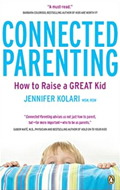
Title: Connected Parenting: How to Raise a GREAT Kid
Author: Jennifer Kolari
Source: Veddma library
ISBN: 978-0-14-316877-5
Available online
Notes: The author stresses that empathy is the key to raising a child.
The formula to correct a child’s behaviour is:
1) Mirror to show you understand the child’s feelings.
2) Present a disciplinary problem and explain why the behaviour is unacceptable.
3) Find a solution by either suggesting a course of action or imposing a consequence.
She introduces the CALM acronym for her parenting strategy:
Connect – show undivided attention.
Affect – genuinely match the child’s tone of voice, body language, facial expression.
Listen – listen attentively and carefully to the exact words the child is using.
Mirror – bring it all together.
Sometimes if the relationship has been deteriorating for a long time, you first have to repair the bond with the child. This can be done via baby play (playing with the child as if they are a baby again), parenting together with your partner or other family members, being sincere even when you have to admin you were wrong, and remembering that it is never too late to repair the relationship.
To keep the child happy and well-behaved, spend time with the child (just like you would if you wanted to maintain any other relationship): play with the child regularly, give them all your attention, catch them when they are being good and commend their achievement, try not to say “later” too much: it does not take long to bring your child to a happy place.
To set appropriate limits which every child needs, you must find a medium between an all-permissive and an all-forbidding approach. All children need limits, otherwise the world is too uncertain for them, and they do not want to be in charge. Do not be embarrassed by the child misbehaving in public and do not ignore it or the behaviour will escalate. Address the issue and remove the child from the situation if necessary.
Say what you mean and mean what you say. If you promised the child a consequence for a specific action, you must enforce the consequence if the child chooses to perform the action. This means that the consequence should be the one you are willing and able to enforce. Setting limits prepares children for life: if they know what the appropriate behaviour in the situation is, they feel more in control and can make better decisions.
Get familiar with your own limits and triggers, and monitor your own stress level so you do not overreact. Decide on the behaviour’s category: is it a red-light behaviour (absolutely unacceptable, endangering life or health), green-light behaviour (nothing earth-shattering), or yellow-light behaviour (something that is ok in exceptional circumstances). Familiarize your child with the system, and explain that red-light behaviours will not be tolerated, and yellow-light behaviours can be ok only once in a while, upon your permission). That way the child knows the limits before they overstep them.
The author mentions front-loading and intervention as two strategies for containment. Front-load: let your child know what to expect, know when the situation is going to be tough to handle for a child (such as sitting still for 2 hours at a restaurant) and plan in advance to mitigate the situation. For multiple children, present the concepts of “friendship moves” (statements or actions encouraging friendship) versus “friendship blocks” (statements or actions hurting feelings and deteriorating friendship). Explain that you expect them to perform friendship moves toward each other. Acknowledge and encourage instead of threatening or bribing.
Intervention involves planning for the worst: you explain the exact situation and consequences to the children up-front and if they do not do what you require, you carry through with the consequence. If that means leaving the restaurant in the middle of dinner without letting kids enjoy food or dessert, then that is what you do in case they go against what you have requested them to do. This provides the child with a lesson to be learned, and next time they will know you mean what you say and you are prepared to go through with the consequence.
The author suggests different approaches to intervention: cure the bad behaviour with kindness, laughter, imaginary play, and cuddling – a child who feels loved will be more likely to listen to you. If a child throws a tantrum and does not react to calming techniques, allow them to continue the tantrum in a safe space and without an audience. That will likely make it boring and the child will stop. Play an adrenaline-releasing game (chasing, hiding, tumbling) to let the child discharge their excess energy and release their emotions. Making an observation and walking away instead of saying “no” leaves the child to think about the situation and make their own decision. For younger children distraction is a good technique. If one technique does not work, try another. What did not work today might work tomorrow.
The book goes into details of special situations (homework, bathroom routines, getting dressed), modifying the mirroring techniques for special-needs children, and troubleshooting common problems.
Overall a good book on parenting coming from a place of compassion, understanding, and setting limits. It contains lots of examples of specific situations and ways dialogues with children develop, and presents possible solutions.





